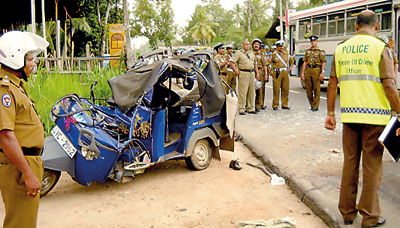Bus Rapid Transit (BRT) system solution to crowded Colombo roads
Though researchers and professionals make a lot of effort to prepare research based on result-oriented situations elsewhere in the world, this research doesn’t get integrated in Sri Lanka’s national development system. This was one of the observations that emerged during a discussion at the 10th Annual John Diandas Memorial lecture that was delivered by Dr T. Sivakumar, Head, Department of Transport and Logistics Management, University of Moratuwa in Colombo last week. Organised by The Chartered Institute of Logistics and Transport, Sri Lanka, the topic of discussion was “Is Bus Rapid Transit a viable solution to relieve congested Road Space in Colombo”?
While the need for a National Transport System was noted, a member of the audience pointed out that a suggestion made by Mr Diandas some 28 years ago for some improvements in the Sri Lanka Railways is yet to be implemented. John Diandas, who died in July 2002, was a Chartered Accountant by profession and a specialist in such fields as electricity, energy and transport. He was the country’s foremost authority on transportation and widely respected for his views on this sector. Dr Sivakumar said that the factors contributory to congestion are multifaceted like the growing population and their mobility in transport modes to cities and the inadequate infrastructure, poor traffic control, poor land use control, indisciplined drivers and road users.
He said that it costs more to the society in terms of lost hours in traffic, longer commuting times and the informal sector such as cars and motorcycles are all contributing to congestion. Dr Sivakumar said cities in developing countries face severe transport problems due to rapid growth in economy, urbanization and migration of people to cities. Some 3.9 billion people in Asia account for 61% of world population and the rate of growth by 2030 would be around 54%. He said the Asian Development Bank has estimated that 80% of Asia’s new economic growth would in future be generated in its urban economies, but large numbers of these cities would be poor and the income mixture would create transport problems in the developing countries. The challenges of the transport professionals are how to break the vicious circle and to relieve congestion. He said that investments in transport infrastructure are based on assumptions on less travel time by increasing speed. But in the macro picture of urban transport, motorization does increase travel speed but, doesn’t reduce travel time for people who tend to travel longer.
He said that congestion could be reduced by having additional lanes in roads but it would attract more cars and with time there would be congestion. He said in most developing countries governments overemphasize on road projects than the projects that support public transport and pedestrian access. He said the congestion problem arises due to the misuse of public space and thus every driver should reconsider the use of public space efficiently and therefore vehicle occupancy must be focused than the number of vehicles on the roads. He said that three-wheelers and motorcycles have been the actual cause of congestion in Colombo.
He said that though mass transit has been provided by the railway, more recently, buses have also been used to provide mass transit in a number of countries – referred to as Bus Rapid Transit (BRT) – which is effective to move large numbers of people across urban areas and which is also significant in developing countries.BRT meets the challenges with highest freedom of route flexibility. He said that investment costs for the BRT are significantly less compared to the railway. Dr Sivakumar cited the examples of cities of countries like South America, North America, China, India Australia and Africa and pointed out that they are successfully operating BRT.
He said, “If we were to implement BRT firstly we must think whether we have planned and worked out enough to get natural support from land use integration; system integration; institutional arrangements and political support and user acceptance”. He said BRT is a viable solution to relieve congested road space in Colombo and it must be the take-off system for Colombo before the authorities step into any higher order transits.
comments powered by Disqus
























